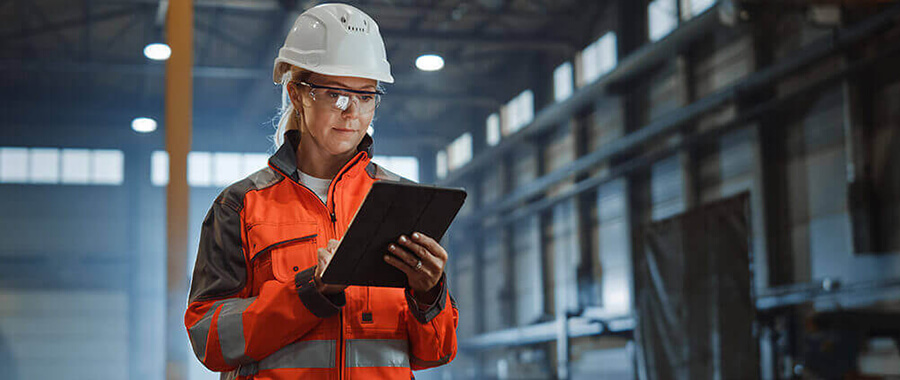Material Handling Safety Audit

Fire Risk Assessment by TheSafetyMaster
September 1, 2023
Top Safety auditing Company of India TheSafetyMaster
September 2, 2023Material handling is a critical aspect of any industrial or warehouse setting. From transporting heavy equipment to organizing inventory, efficient and safe material handling practices are vital for maintaining productivity and preventing accidents. However, ensuring the utmost safety in these operations can be challenging without proper assessment and implementation of appropriate measures.
In this comprehensive article, we will delve into the world of material handling safety audits – a systematic approach to identifying hazards, developing safety policies, training employees, and implementing measures to enhance workplace safety. Whether you are a facility manager looking to improve your current safety practices or an employee concerned about your workplace’s well-being, this article promises to provide invaluable insights and actionable steps towards achieving a safer working environment.
The Importance of Material Handling Safety
Ensuring the safety of workers should be the paramount concern for every organization, and this holds particularly true when it comes to material handling. The process of moving, storing, and controlling materials within a facility presents numerous hazards that can lead to accidents, injuries, and even fatalities if not managed effectively. Hence, understanding the importance of material handling safety is crucial in creating a safe and productive work environment.
By prioritizing material handling safety, organizations can significantly reduce workplace incidents and their associated costs. A comprehensive approach to safety not only protects employees from harm but also improves productivity levels by preventing downtime caused by accidents. Furthermore, a safe workplace cultivates employee morale and satisfaction, fostering a positive organizational culture that values the well-being of its workforce.
Assessing Your Current Safety Practices
Before embarking on the journey of improving material handling safety, it is imperative to assess your current safety practices. This assessment serves as a foundation for identifying areas that require improvement and implementing effective safety measures.
Begin by conducting a comprehensive review of your existing safety policies and procedures. Evaluate the extent to which they align with industry best practices and regulatory standards. Take note of any gaps or inconsistencies that may compromise the well-being of your employees and the efficiency of your material handling operations.
Next, observe the day-to-day practices in your workplace. Engage with employees at all levels to gain firsthand insights into their understanding and adherence to safety protocols. Encourage open communication, as it will provide valuable feedback on potential safety issues that may have been overlooked.
Analyze incident data, near-miss reports, and injury records for patterns or trends related to material handling accidents. This analysis will help you pinpoint high-risk areas or activities that necessitate immediate attention. Additionally, consider conducting interviews or surveys to gauge employee perception of safety culture within your organization.
The goal is not to merely identify weaknesses but also acknowledge areas where safety measures have been successful. Celebrate achievements and highlight positive outcomes resulting from existing protocols or initiatives undertaken in the past. This balanced approach fosters a sense of optimism among employees, promoting their engagement in future improvement efforts.
Step-by-Step Guide to Conducting a Material Handling Safety Audit
Performing a thorough material handling safety audit is crucial to identify potential hazards, assess the effectiveness of your current safety protocols, and ensure the well-being of your workforce. Follow these step-by-step guidelines to conduct a comprehensive audit:
1. Prepare: Begin by gathering relevant documents such as safety manuals, incident reports, and training records. Communicate with key stakeholders to establish goals and expectations for the audit. Allocate adequate time and resources for the process.
2. Formulate an Audit Team: Assemble a team of knowledgeable individuals from various departments within your organization who can contribute valuable insights during the audit process. This diverse group should include representatives from management, operations, maintenance, and health and safety.
3. Create an Audit Checklist: Develop a detailed checklist that encompasses all relevant areas of material handling safety, including equipment maintenance, ergonomics, training programs, emergency response procedures, and compliance with regulations. The checklist will serve as a roadmap during the audit.
4. Gather Information: Conduct interviews with employees at all levels to gather information about existing safety practices and potential areas of concern. Observe work processes firsthand to gain deeper insights into how materials are handled throughout various operations.
5. Evaluate Policies and Procedures: Review existing safety policies and procedures against industry best practices and regulatory requirements. Assess their effectiveness in reducing accidents or injuries related to material handling activities.
6. Analyze Hazard Identification Practices:
When conducting a material handling safety audit, one of the crucial steps is identifying potential hazards and risks within the workplace. This involves a meticulous examination of all aspects of material handling operations to ensure the safety of workers and the prevention of accidents. The goal is to proactively identify any elements that may pose a threat to employees’ well-being.
During this phase, it is essential to consider various factors that can contribute to hazards and risks. For instance, evaluating the physical layout of the facility allows us to identify potential tripping or collision points. Additionally, analyzing equipment such as forklifts, conveyors, and cranes helps pinpoint any mechanical malfunctions or inadequacies in their design. Furthermore, a comprehensive review of storage systems can reveal potential issues related to overloading or improper stacking.
Developing Safety Policies and Procedures
When it comes to ensuring material handling safety, developing robust policies and procedures is crucial. These written guidelines serve as a roadmap for your organization, outlining the specific measures that need to be taken to minimize risks and promote a safe working environment. The process begins by conducting a thorough assessment of the current practices in your facility.
Your safety policies should be comprehensive, covering all aspects of material handling, including equipment usage, storage procedures, lifting techniques, and emergency protocols. It is important to involve key stakeholders in the development process to gather diverse perspectives and ensure buy-in from all levels of the organization. By establishing clear expectations through well-defined policies, you lay the foundation for a culture of safety that permeates throughout your workplace.
Training Your Employees for Safe Material Handling Practices
Ensuring that your employees are equipped with the necessary knowledge and skills to handle materials safely is paramount in maintaining a secure work environment. Effective training programs not only empower individuals to perform their duties with confidence but also foster a culture of safety throughout the organization.
When it comes to training employees for safe material handling practices, there are several key elements to consider. Firstly, conducting thorough hazard assessments can help identify potential risks and tailor the training program accordingly. This ensures that employees receive targeted instruction on how to mitigate specific hazards they may encounter in their daily tasks.
Maintaining engagement during the training process is crucial. By incorporating interactive elements such as role-playing exercises or hands-on demonstrations, employees are more likely to retain information and apply it effectively in real-life scenarios. Additionally, incorporating visual aids or multimedia resources can enhance comprehension for individuals with different learning styles.
Regularly assessing the effectiveness of your training program through evaluations and employee feedback allows for continuous improvement. Encouraging open communication channels where employees can voice their concerns or suggest potential areas of improvement fosters a sense of ownership and collaboration within your organization.
By investing time and resources into comprehensive material handling safety training, you not only prioritize the well-being of your workforce but also cultivate a positive work environment built on trust and shared responsibility. Remember, an educated workforce is an empowered one!
Implementing Safety Measures and Equipment
In order to ensure the highest level of material handling safety, it is crucial to implement appropriate safety measures and equip your workplace with the necessary tools and equipment. This not only minimizes the risk of accidents but also promotes efficiency and productivity. One key aspect is establishing clear signage throughout the facility, using bold colors and concise language that can be easily understood by all employees.
Another crucial step is providing personal protective equipment (PPE) to your workers. This includes items such as hard hats, safety goggles, gloves, and steel-toed boots. By equipping your employees with these essential tools, you demonstrate a commitment to their well-being while fostering a sense of security in their work environment.
Furthermore, investing in ergonomic equipment can greatly enhance safety during material handling tasks. Adjustable workstations, lift-assist devices, conveyor belts with adjustable heights, and strategically placed handrails are just a few examples of how ergonomics can be incorporated into your workplace design.
Additionally, implementing technology-driven solutions can further enhance safety measures. For instance, utilizing automated guided vehicles (AGVs) or robotic systems in material handling processes minimizes human error and reduces potential hazards associated with manual lifting or carrying heavy loads.
Monitoring and Evaluating Safety Performance
Once your material handling safety protocols are in place, it is crucial to establish a systematic approach for monitoring and evaluating safety performance. This ongoing assessment allows you to identify any potential gaps in your safety measures and make necessary improvements. By diligently tracking the effectiveness of your safety policies, you can ensure a safe working environment for your employees.
One effective method of monitoring safety performance is by conducting regular inspections and audits. These assessments involve inspecting equipment, observing work practices, and assessing compliance with established safety protocols. By actively engaging in these evaluations, you demonstrate your commitment to maintaining a high standard of safety in your workplace.
Furthermore, it is essential to collect relevant data on incidents, near misses, and any other safety-related occurrences. This data serves as valuable insight into potential areas for improvement. By analyzing trends and patterns within the collected data, you can proactively address any emerging risks or issues.
In order to foster a culture of continuous improvement, it is important to communicate the findings from these evaluations with your employees. Recognize their efforts towards creating a safer work environment and celebrate successes achieved through their participation in adhering to safety guidelines. Engaging employees in this process not only boosts morale but also encourages them to take ownership of their own individual safety as well as that of their colleagues.
Sharing Success Stories: Real-life Examples of Improved Material Handling Safety
One of the most powerful ways to motivate and inspire change within an organization is by sharing success stories of improved material handling safety. These stories not only highlight the positive outcomes and achievements but also serve as a testament to the effectiveness of implementing robust safety measures and protocols.
Take, for instance, a manufacturing company that decided to overhaul its material handling practices after a series of incidents. By conducting a thorough safety audit and identifying areas for improvement, they implemented enhanced training programs, upgraded equipment, and developed clear policies and procedures. The result? A significant reduction in workplace accidents and injuries. Not only did this improve the well-being and morale of employees but it also led to increased productivity levels, as workers felt safer and more confident in their tasks.
Inspiring a Culture of Safety: Encouraging Employee Engagement
Creating a culture of safety within your organization is essential to ensure the long-term success of your material handling operations. While implementing safety policies and procedures is crucial, engaging your employees in the process is equally important. By fostering a sense of ownership and responsibility, you can inspire them to actively contribute to maintaining a safe working environment.
One effective way to encourage employee engagement in safety practices is through regular communication and training sessions. These sessions should go beyond simply instructing employees on safety protocols; they should also emphasize the importance of their active involvement in identifying potential hazards and reporting safety concerns promptly. By empowering employees with knowledge and skills, they will feel more confident in their ability to contribute meaningfully to the overall safety efforts.
Conclusion
In conclusion, conducting a material handling safety audit is not just a necessary task for compliance, but a crucial aspect of creating a safe and efficient workplace. By identifying potential hazards, developing comprehensive safety policies, training employees effectively, and implementing robust safety measures, organizations can significantly reduce the risk of accidents and injuries. It is important to remember that the ultimate goal of these audits is not just to meet regulatory standards, but to cultivate a culture of safety where every employee actively participates in creating a secure work environment. By prioritizing material handling safety, we can enhance productivity and ensure the well-being of all individuals involved.
With Best Wishes
Sanjeev Paruthi
TSM TheSafetyMaster® Private Limited
Unit No 221-451-452, SPL1/J, 2nd & 4th Floor, Sunsquare Plaza Complex, RIICO Chowk, Bhiwadi 301019, Rajasthan, India
Phone: +91 1493 22 0093
Mobile: +91 7665231743/9413882016
Email: info@thesafetymaster.com




